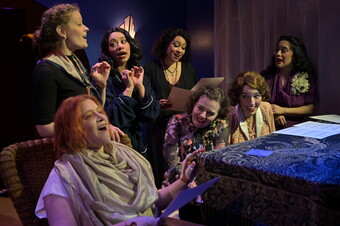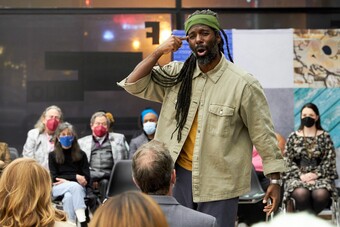(Re)Search
Using People as Resources; or How I Learned to Love To Ask
(Re)Search is a six part series by Bree Windham a current graduate student in dramaturgy. It details her experiences as a young dramaturg navigating different resources and the ways she has come utilize them through trial, error, and advice from others. Find the full series here.
I did not start out in theater as a dramaturg. When I was an undergraduate, I thought I was destined to become a props master. Despite my lack of sewing skills (even after being taught) and my unavoidable clumsiness, I was sure this is where my life was taking me. This was all until I was the properties master for my university’s production of Picasso at the Lapin Agile by Steve Martin. For those of you unfamiliar with the play, it is set in the Montmartre district of Paris and features the unlikely meeting of Pablo Picasso, Albert Einstein, and Elvis at a lovely little bar called the Lapin Agile.
The set designer made it clear that she wanted a literal interpretation of the Lapin Agile—the set needed to look like it was transplanted from the actual bar. I had no idea of what this meant, so I set out to the library and checked out every book on the Montmartre district that I could find. I found numerous pictures of the owner and famous artists. I found anecdotes about Picasso and other artists trading their art for a drink. And other stories of students who used the bar owner’s donkey to make their art—they tied a paint brush to is tail, and when it was finished swishing around, they would sell the paintings, under a pseudonym, for a good deal of money. It seems the donkey was an abstract artist ahead of its time. I could go on, but suffice it to say, I became immersed in the world of the play. It was at this time that someone suggested I look into dramaturgy. I had never heard the term. This experience taught me to ask for information. And to me, dramaturgy in and of itself, is about asking.

With the goal of accurately recreating the Lapin Agile, I set out to the library again (with a smile on my face). I have always been a firm believer in the K.I.S.S. system (Keep It Simple Stupid) when it comes to researching and I believe this next experience really solidified my stance. I went straight to the drama librarian, who helped me locate a few more books. Then I quickly realized that to find photos of this bar would likely require that I scour the background of old photographs for hours. As an undergrad taking a full course load, this wasn’t going to fly with me.
It’s easy to start researching and feel alone. But when you step back for a moment, know that you are not only surrounded by friends who have knowledge to share, but also by a passionate and informed global community.
Instead, I decided to Google the Lapin Agile. If they somehow had a website, maybe it would have photographs of the bar. Turns out, the Lapin Agile was still in operation. And then I saw it—a “contact us” link at the bottom of the page. I sat there for a minute before I actually clicked the link. Could it be that easy? The thought of pulling an all-nighter playing Sherlock Holmes with some early 1900’s black and white photos propelled me forward.
I wrote: Hi my name is Briana Windham. I am in Auburn, Alabama, United States and I am working on a play that is set at your bar in the early 1900s. I would like to know if you have any information you think is crucial to depicting your bar. Do you have any specialty drinks? Any information you are willing to share would be much appreciated. Thank you.
Miraculously, they responded with a great deal of information and even gave me the recipe for a drink the original owner was known to make. Our set looked amazing. Did it look exactly like the original bar? No. But with the information that the current owner provided, it felt like it should.
Picasso at the Lapin Agile was my last production as a props master. The research I did for that play still sits in a binder on my desk. It reminds me of the joy I feel when I connect with someone over a shared experience. That joy is something I search for on every production I research. And honestly, more often than not, I find it. Not in books or periodicals, but with human connection.
My biggest learning moment was learning there is no harm in asking. Whether it’s calling theaters that have previously done the show I’m working on, or my local record store, or putting a question out to the Facebook hive mind, I’ve done it all. And usually, it works.
It’s easy to start researching and feel alone. But when you step back for a moment, know that you are not only surrounded by friends who have knowledge to share, but also by a passionate and informed global community. The keys to a historic Montmartre bar are literally a click away. All you have to do is ask.














Comments
The article is just the start of the conversation—we want to know what you think about this subject, too! HowlRound is a space for knowledge-sharing, and we welcome spirited, thoughtful, and on-topic dialogue. Find our full comments policy here